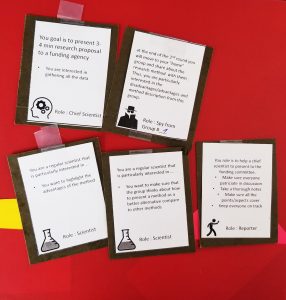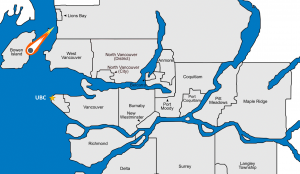During my first teaching practicum, I was teaching a 4th-year course at my department (EOSC470 Biological Oceanography). This is an upper-level course offered though EOAS Department at UBC where students are exploring the marine ecosystems, factors, and processes responsible for distribution and abundance of marine organisms.
I wanted to create a more engaging fun lesson as I noticed that the “level of fun” is decreasing with the increase in course level in my department. Thus, almost all upper-level courses in my department are primarily taught by lectures with little focus on any activities (with the exception of worksheets and small group discussions). On the other hand, the lower level courses have a greater variety of various activities that are more creative and engaging for students.
So, my goal was to challenge myself to teach a hard upper-level topic in a unique and engaging way. During the lesson, I was aiming to accomplish the following aims:
- My challenge was to structure the lesson in the more experimental learning set up, rather than as a “standard“ lecture.
- Simulate the “real-world” experience in a group discussion setting
- Build up teaching confidence in teaching the material
Experimental Learning Set Up
I chose a topic of Estimation of Secondary Productivity. This is a quite complex topic that describes different methods how the secondary production can be estimated with the stress on the limitations and assumption of a given method.
I tried doing Experiential Learning lecture where the main role in the classroom was given to students rather than the lecturer. Thus, all the quality and the amount of information that is produced during the class is entirely dependant on the students. This is a completely new approach for me as I am more comfortable having more control over the class. Hence, My role was only to moderate the lecture to make sure that students understand their roles and the outcomes of this lesson and also help if I see them struggling during the activity.
Group Discussion Setting
I believe that all scientific discoveries and inventions are primarily done through collaborations rather than individual work. That is why I structured my lesson as a group discussion to simulate the teamwork in the scientific community. The goal was to compete for funding from a research agency to obtain the money to perform the experiment using one of the methods to estimate secondary production. However, to make the classroom experience more unique, I structured the group work in a game format similar to the “Mafia.”
Using my skills and experiences from a resource development for various courses, I designed a completely new game that I called “Science Mafia.” The game is designed to simulate the experience in scientific community and allow students to have an ability to practice the role-playing, skills. So each team had a chief scientist who was responsible for presenting the outcomes of their group work, reporters who helped taking notes and regular scientist that had various roles ( e.g., one scientist were more interested in the disadvantages of the method, the other was more interested in highlighting the significance of the method).

Example of cards for class activity
Thus, each student was contributing to the overall conversation within the group and while focusing on different aspects of the method that I wanted them to pay attention too. However, each group was doing only one method that they were assigned, thus, to make sure each group can learn about another method each of the groups had a “spy” whose role was at the end of the class to switch to another group and share with them everything they learned about other group methods. Thus, all groups had a chance to learn about all the methods. In addition, spies also could switch the roles their team members have so any one of them can end up with a different role each round.
Teaching Confidence
I have never taken any courses related to Biological Oceanography and of course, never took the EOSC 470. Thus, not only I am lacking the Pedagogical Knowledge, but also, I am limited by the Content Knowledge.as a result, I was not feeling confident in the material I chose to present. However, I made it as my additional challenge to become confident in things I had never done before or studied myself.
To make myself more confident, I designed a lesson plan where I scheduled minute by minute activities and wrote down specific steps how to conduct the activity, how many minutes each step of the activity should take to make sure I have enough time to finish the exercise. To have a certain structure in the class, even though the outcome of the lecture will primarily lay on the students allowed me to have a certain control over the group dynamics and the course of the lesson.
Disciplinary Behaviours
I was trying to emphasize the following aspects that are common in my area:
- Independent work. students were expected to read and analyze paper on their own and make a summary based on the given questions given
- Group/ collaborative work. During the classroom, students were role-playing the “scientific ”
- Proficiency in Analysis of the scientific literature, limitations, and assumptions
However, to make sure that students can pay attention to these behaviors, I wanted to make sure that they have some background knowledge in the studied topic to have enough confidence actually to practice these behaviors. Students also need to have a certain level of expertise to find certain activity effective. Thus I asked them to read a paper and do a small analysis before coming to class. As the class is made up of 4-year students, I felt that this wouldn’t be very problematic for them as they have been already trained in how to read and analyze the scientific paper.
Short Coming and Future Work
Overall, I think the class went OK. I was happy with the amount of work being done during the group’s discussion and the level of participation ( in general) of the students in the actual material. I also asked the students to give me a written anonymous feedback on my lecture. Based on the feedback students liked the following aspects of my teaching:
- Interactive class, funny set up and engaging activity
- Papers were straightforward to read
- Good public speaking
- Clear
- Well prepared
The following shortcomings have been identified:
- Improve the motivation of students to “do their homework.” Although the lesson before it was emphasized that students have to come prepared for the class by reading a paper and taking notes, it seemed that only a few people accomplished it. Thus, next time I can stress out that the material that will be covered in class will be part of the midterm and they will only get as much material as their group work. Thus, poor participation and preparedness to the lesson may result in very poor material gathered during the class, and, as a result, will not be sufficient to get a good grade on the final exam. The other way is to make sure students are ready is to set up an online test/quiz that will allow me to ask students the required questions and make sure that their level of knowledge is sufficient enough for the participation in the classroom.
- class management The other issue that I have been identified by my observer is the lack of class managements skill due to low self -esteem. I found it to be impossible to pose yourself as an effective instructor and hold student attention while you doubt yourself and your teaching style. As a result of doubting myself whether my lesson is “ good enough” for the upper-level class, I found myself to be extremely nervous, talking too fast during the explanations,
- Flexibility. Also, for the future, I would like to learn to be more flexible in my teaching, as I over-plan certain things. For instance, I planned 2 min “breaks” where students were basically given time to rest from the actual material and participate in a conversation with peers. I thought that the would be highly desired for the students and will even take more time. However, I found that students were not engaging in any talks with each other or their conversation was minimal. Thus, I should have modified my lesson plan right away to shorten that break time and allowing more time to do a discussion on the studied topic rather than trying to push them to engage in those conversations.
- Lesson Summary. To have a more solid summary at the end of the class was a requested thing both by the observer and students. Although at the end of the activity, the groups produced the worksheets that had a summary of each method. After class, I compiled all the material they had and uploaded all of their work on Canvas. However, there should be some sort of clear summary at the end of the class. Although I did mention about the information, they will be asked on the final exam, and what kind of things they supposed to know, maybe a summary slide would be nice to put on n my presentation so that students can access how well they performed during the class and how much they actually covered in their group.



